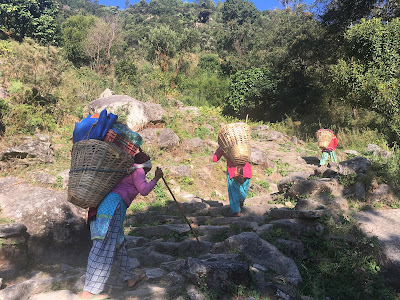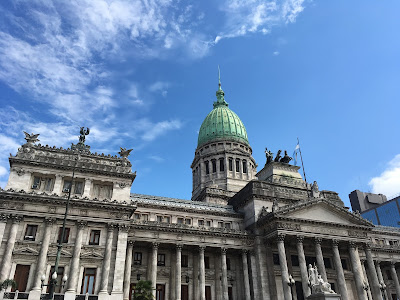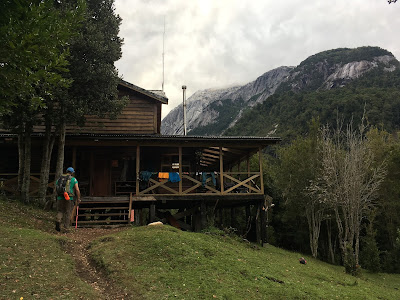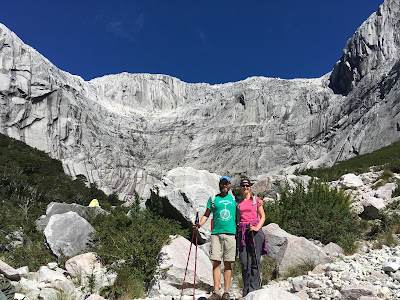I (Kenzi) could write a book on my thoughts from this year, but I’ll try to keep it *kind of* short. This year has been so hard in some ways and so easy in other ways, and inspired much growth, and much thought. There were stressful moments and incredibly relaxing times. And of course, it was the full spectrum of emotions: uncomfortable, confused, elated, frustrated, joyful, amazed, lonely, etc. We took approximately 10,000 photos (yikes) and a shameful number of them were selfies, but at least we never got a selfie stick!
 |
| Early in our year of selfies, Amsterdam |
First of all, what is it like to travel with one's spouse? Well, I guess we're lucky because for us it was pretty easy. It was a bit of an adjustment to spending EVERY. SINGLE. MINUTE. together, but I think we both got really accustomed to it and are likely to go through withdrawals now that we've returned home. We've had countless hours of shared silence, countless mundane conversations, many thoughtful political and philosophical talks, hearty laughs, too many games of backgammon, and shared so many stories and memories from our pasts that probably never would have come up otherwise. For example, while hiking for a total of 18 days in Nepal, many random memories rose to the surface that I was able to share with Bill that I am confident would not have come up during our normal home life. Every time we moved to a new place, which was basically every few days, I liked to unpack and put things in their place. It was a way for me to feel at home. Bill didn't need such a crutch. One of us uses the best travel invention for organized people: packing cubes. One of us doesn't... I'll let you decide which.
Watching each other react and process a variety of foreign interactions and experiences was enlightening and sometimes frustrating when we didn't agree on how to interpret something. We also got to hear each other fumble through foreign conversations, which is basically the height of comic relief. But truly, this year was an incredible gift for our marriage.
Secondly, managing health while traveling went pretty smoothly overall, especially for Bill. I have a sensitive body that sometimes overreacts to benign things. During our first 6-month chunk of travel, I had two week-long colds, and a bout of week-long traveler's diarrhea, thanks to late night Indian food. I also struggled with breathing while at high altitude in Nepal. This was all fairly normal, or at least to be expected. However, I felt a bit off for at least half of our time in South America due to a large variety of minor things: altitude sickness, several bouts of mild traveler's diarrhea, painful sinuses in the desert, random nausea, and migraines, among other things. But thankfully, we never had any major injuries or illnesses while traveling. No hospital visits, no sprained ankles or broken bones, and it was easy to get cheap prescription drugs while abroad. I experienced some unexpected anxiety during the fall, which was new and exciting in a very unpleasant way. It generally manifested as claustrophobia, which is pretty tough to manage as a tourist when you’re often crammed in trains, planes, buses, elevators, etc. But thankfully, it eased up after Nepal in October. I think I was just nervous about all that hiking in such a remote location, when I’ve never done anything like that before in my life.
 |
| Best travel invention: packing cubes! |
 |
| Me after winning 5 backgammon games in a row, a miracle! - (Argentina). |
 |
| Traveling was good for our marriage. Talk about having lots of quality time! (Slovenia) |
We did more hiking this year than I've done the rest of my life combined, about 30 days, an entire month of hiking. We hiked in Italy, Slovenia, Nepal, Laos, Peru, Chile, and Argentina. After a long day of hiking, I was often struck by just how far we could go just by walking on our own two feet. Our longest day was 19 miles. According to the pedometer on my phone, we walked 1880 miles this year, which is an average of about 5 miles a day. It has been so nice not to sit at a desk every day!
 |
| Feeling pretty proud at the end of 18 days of hiking in Nepal, probably the fittest I'll be in my adult life. |
And that brings us to the topic of bathrooms. We've seen it all! We often had a rating system. Was it a sit-down or squat toilet? If sit-down, was there a toilet seat? Did it flush, or did you have to throw a bucket of water down the toilet? Was there toilet paper? Could you flush the paper or did you have to throw it in a trash bin? And in Nepal, was the ceiling of the outhouse covered in spiders? Was the ceiling so low that you had to squat before you even got on the squat toilet? We literally used so much hand sanitizer in Nepal that the skin on Bill's hands peeled off. I don’t believe anyone should have to pay to use a bathroom, but we did many times, and often we did so happily out of desperation. Believe me, we have seen it all.
Parts of me really enjoyed the simple living: wearing the same clothes over and over, not wearing makeup very often, not having to wade through hundreds of emails every day. But the “princess" parts of me rose to the surface with an embarrassing vengeance. Turns out I have to wear earplugs and an eye mask to sleep in new places. Turns out I get a bit irritated when there is no toilet paper, no hand towel, no kitchen towel or paper towels, no soap, no trash can, etc. It really made me appreciate SO many of our daily comforts, including walkable sidewalks (it is not uncommon in other countries to trip regularly on uneven sidewalks, or have to dodge deep holes (6 ft deep!) in walkways).
And now for the more thoughtful stuff:
 |
| This is a sidewalk from my walk here in CA last week. SO FLAT and perfect! |
Traveling in spite of fear is tricky, but so incredibly worth it. There's the man-made stuff to be afraid of like the Munich shooting and the bombing in Nice, France, and the coup in Turkey. And then there's the nature-inspired stuff to be afraid of like the earthquake in Italy, the earthquake in the Nepal, and the flooding in Santiago. We definitely had moments of anxiety when things around us just didn't feel quite right, or we were just plain confused about what was happening around us. Also, we both really wanted to go to Turkey but right when we were booking tickets, they were in the midst of their coup, so we didn't end up going. It was a big disappointment, so I guess we'll need to plan a trip at a later time. But generally speaking, we moved forward with our plans despite any fears or uncertainty, and our travel in the Middle East (Egypt, Isreal, and Jordan) was so rewarding and interesting. We are so happy that we went.
I can't say enough good stuff about travel. We both traveled pretty extensively before this year-long extravaganza, so we were immune to some of the wide-eyed experiences one has on their first trip abroad. However, longer term travel allows some of those initial lessons to really sink in to your bones. I thought a lot about privilege this year: the privilege I have as a Westerner, as a tall person, as a married person, as a white person. There were some situations that were pretty uncomfortable for me, usually related to creature comforts, but I always knew that we would be leaving that uncomfortable place in a few days. I was constantly reminded that SO MANY people in our world don't have the option to leave. They are stuck in whatever uncomfortable, unclean, unjust, unfair situation for years, or even for life. What if I could never leave? How would my definition of comfort/hygiene/justice change? How would my perception of my own value and self-esteem change?
 |
| Making friends in the Middle East |
I also cannot speak highly enough about the experience of being a minority. I believe so strongly that every American should travel abroad, but more importantly, every American ought to experience the discomfort of being the minority, the confusion of not understanding the native language, the stares of the locals, the feeling of being utterly lost in a foreign land. We relied heavily on the friendliness of strangers throughout the year, and I think that knowing what it feels like to be in the minority really softens ones heart toward immigrants and foreign visitors at home. Being in Muslim countries like Egypt, Jordan, and Malaysia was such a valuable and enlightening experience. I guess what I’m trying to say is that seeing other cultures makes you realize that there are many ways to live, all equally fine, each with pros and cons. Ours isn’t the only way.
I think about women a lot. As they say, "women hold up half the sky". I have an even deeper respect for the ladies of the world having traveled this year. Women carry a heavy load, sometimes literally (and sometimes on their heads). I love seeing the variety of shapes and sizes, skin colors, eye colors, fashion expressions. The women of India in their brightly colored saris are basically walking pieces of art, simply gorgeous. One of the things I like about Muslim women wearing head scarves is that it’s easier to look into their eyes, fewer distractions. I love that Argentina requires quotas of women in their parliament. As women across the world slowly tip the scales of gender equality, as we've traveled, it's shone a light for me on the work yet to be done and the ways in which we're behind in America.
 |
| Inside the absolutely stunning Mohammed Ali Mosque in Cairo |
 |
| Women carrying heavy loads up a steep section of the Poon Hill trek in Nepal (they are wearing flip flops). |
 |
| A lady porter carrying a SUPER heavy load so that tourists only had to carry day packs (Nepal). |
 |
| We were in Vietnam during the election and in Columbia during the inauguration. |
People have often asked what our favorite place was. Naturally, it’s really difficult to answer that question. But some highlights were:
Best for history: Italy, Greece, Egypt, Israel
Best surprisingly cool place: Meteora, Greece
Best cliche experience: Riding camels next to the pyramids at Giza
Best achievement: Trekking in Nepal
Best historical/architectural remains: Angkor Wat (Cambodia) Machu Picchu (Peru) and Petra (Jordan)
Best beaches: Thailand
Best big city: Hong Kong
Best water adventure: Sailing the San Blas Islands of Panama
Best mountains/hiking: Nepal and Patagonia
Best flowers: The Netherlands
Best day to day: Sunsets all over the world!
Finally, some brief questions/observations:
Best flowers: The Netherlands
Best day to day: Sunsets all over the world!
 |
| Sunset over Halong Bay, Vietnam |
Why in the heck are we not on the Metric system? The rest of the world is, so it seems ridiculous that we're not.
Anna and Elsa (from Frozen) are everywhere in the world. There is no country safe from them!
Much of the world doesn't have dishwashers or clothes dryers, and they’re doing just fine.
It's a little disheartening to see some of the things that America has exported: a Hooters in Phnom Penh, Subways everywhere, KFC everywhere...
It's a little disheartening to see some of the things that America has exported: a Hooters in Phnom Penh, Subways everywhere, KFC everywhere...
We met some amazing fellow travelers along the way. They tend to be interesting, well-informed, and inquisitive.
We really enjoyed seeing strange and interesting animals all over the world (coatis, elephants, giant centipedes, caimans, wild toucans, llamas, and so much more).
We really enjoyed seeing strange and interesting animals all over the world (coatis, elephants, giant centipedes, caimans, wild toucans, llamas, and so much more).
There are so many places we didn’t get to see. Turns out a year just isn’t enough time! Some of the places that are still on our list:
New Zealand
Galapagos
Scandanavian countries
Turkey
Africa
Africa
More of Mexico!
Thank you so much for traveling the world along with us. We loved getting your feedback and reactions as we went and we look forward to catching up with you as we get settled back into "normal" life.
Thank you so much for traveling the world along with us. We loved getting your feedback and reactions as we went and we look forward to catching up with you as we get settled back into "normal" life.
 |
| Meteora, Greece |
___________________________
Bill's perspective
As I get ready to go back to my previous job, probably the same desk and phone number I can't help but feel incredibly grateful that we were able to pull this off. My Italian mom and grandmother had a saying something along the lines of "when you have the teeth you don't have the bread, when you have the bread you don't have the teeth." We were in the fortunate position to have the bread and the teeth, so we took a huge bite.
Tallying up the few negatives of a year off: Time away from family and friends. A few bucks less in the bank account. We still visited friends and family along the way and we spent something on the order of what some of our peers spend on cars. No big loss there.
So what were the up sides? I can't stress enough how great it is to spend a year with Kenzi and explore the world while only worrying about the basics of food, shelter and transportation. When we dove into this adventure we weren't sure if we would land on our feet at the end but despite worries about ending up in the poor house we're going to do just fine.
So, on top of spending a year of Saturdays with Kenzi here is the short list of epic things I did, in no particular order:
This is only part of why we did this trip, the central reason was to enjoy life before it was over. I can't tell you how many friends I ran into over our Christmas travel break in the US or talked to over email that didn't even realize that anything close to a year had already passed. In other words a year of their life passed with them hardly realizing.
We have both had jobs for most of our adult lives. I've had some sort of job, either currently or lined up, since I was 14 years old when I started at the counter at McDonalds in high school. In the mean time I've seen friends grind away at day jobs, just like I was doing only to never make it to some ethereal far off goal.
Many people may fall into his category, but two come to mind. One friend had a heart attack suddenly 2 weeks after retirement from a distinguished and arduous career. Another friend was diagnosed with aggressive cancer and never saw her 38th birthday. They both lived life to its fullest but I can't say if they got what they wanted out of life or not, but for me, staring down 40, I was beginning to feel like I had spent too much time for the far off goal of retirement and not enough time enjoying the people around me, the world around me and myself. I know some of my closer friends will laugh at me crying "all work and no play", to be sure, I always do have my fair share of fun, so ultimately the judgment fell on making the call of whether we could pull this off. With parents on both sides capable of taking care of themselves and enough money in the bank to feel comfortable about it we couldn't come up with any good reason not to.
So again, gratitude, gratitude that we were able to do this, gratitude that we have the health and means to do it. Thanks for reading.
Bill's perspective
As I get ready to go back to my previous job, probably the same desk and phone number I can't help but feel incredibly grateful that we were able to pull this off. My Italian mom and grandmother had a saying something along the lines of "when you have the teeth you don't have the bread, when you have the bread you don't have the teeth." We were in the fortunate position to have the bread and the teeth, so we took a huge bite.
Tallying up the few negatives of a year off: Time away from family and friends. A few bucks less in the bank account. We still visited friends and family along the way and we spent something on the order of what some of our peers spend on cars. No big loss there.
So what were the up sides? I can't stress enough how great it is to spend a year with Kenzi and explore the world while only worrying about the basics of food, shelter and transportation. When we dove into this adventure we weren't sure if we would land on our feet at the end but despite worries about ending up in the poor house we're going to do just fine.
 |
| Enjoying time together at Plitvice Lakes in Croatia |
- Spent quality time with my brother and sister-in-law during their pregnancy
- Drank the best white wine with my distant relatives in France
- Reunited with a college friend while checking out the relics of ancient Egypt
- Went paragliding over the the Himalayas
- Flew in a homebuilt plane like mine, below sea level over the dead sea in Israel
- Spent a month looking at 8000 meter peaks in the Himalayas
- For 7 days, woke up in Rome and walked to Saint Peters square
- Got blessed by Pope Francis
- Kitesurfed in the South China Sea off Vietnam, in Colombian Caribbean, and in Panamanian Pacific
- Sailed from Colombia to the San Blas islands of Panama with the best group imaginable
- Saw the Dead Sea Scrolls
- Swam in the Dead Sea
- Held a baby goat in Nepal
- Walked up to Torres del Paine and the Fitz Roy Range in Patagonia
- Saw chunks of ice the size of a building fall into a lake at El Calafate
- Saw the beginning of modern civilization in Greece
- Was an illegal alien in Brazil
 |
| Searching for good chocolate in every corner of the world. |
We have both had jobs for most of our adult lives. I've had some sort of job, either currently or lined up, since I was 14 years old when I started at the counter at McDonalds in high school. In the mean time I've seen friends grind away at day jobs, just like I was doing only to never make it to some ethereal far off goal.
Many people may fall into his category, but two come to mind. One friend had a heart attack suddenly 2 weeks after retirement from a distinguished and arduous career. Another friend was diagnosed with aggressive cancer and never saw her 38th birthday. They both lived life to its fullest but I can't say if they got what they wanted out of life or not, but for me, staring down 40, I was beginning to feel like I had spent too much time for the far off goal of retirement and not enough time enjoying the people around me, the world around me and myself. I know some of my closer friends will laugh at me crying "all work and no play", to be sure, I always do have my fair share of fun, so ultimately the judgment fell on making the call of whether we could pull this off. With parents on both sides capable of taking care of themselves and enough money in the bank to feel comfortable about it we couldn't come up with any good reason not to.
So again, gratitude, gratitude that we were able to do this, gratitude that we have the health and means to do it. Thanks for reading.
 |
| Looking back on an incredible year with gratitude. |




























































